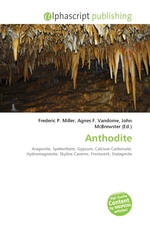Anthodite
Frederic P. Miller, Agnes F. Vandome, John McBrewster
бумажная книга
High Quality Content by WIKIPEDIA articles! Anthodites (Greek, anthos, “flower”, -ode, adjectival combining form, -ite adjectival suffix) are speleothems (cave formations) composed of long needle-like crystals situated in clusters which radiate outward from a common base. The "needles" may be quill-like or feathery. Most anthodites are made of the mineral aragonite (a variety of calcium carbonate, CaCO3), although some are composed of gypsum (CaSO4·2H2O). The term “anthodite” is first cited in the scientific literature in 1965 by Japanese researcher N. Kashima, who described “flower-like dripstone” composed of “an alternation of calcite and aragonite”. The individual crystals of anthodites develop in a form described as “acicular” (needle-like) and often branch out as they grow. They usually grow downward from a cave's ceiling. Aragonite crystals are contrasted with those made of calcite (another variety of calcium carbonate) in that the latter tend to be stubby or dog-tooth-like (“rhombohedral”, rather than acicular). Anthodites often have a solid core of aragonite and may have huntite or hydromagnesite deposited near the ends of the branches.
Данное издание не является оригинальным. Книга печатается по технологии принт-он-деманд после получения заказа.


